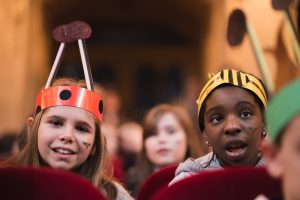Kids and Opera
You may be wondering: why focus on an art form that is apparently so far from our daily lives and difficult to understand? In 1996 Barbara Minghetti and Carlo Delfrati were asking themselves if it could be possible to rediscover opera theatre as a positive experience for a future, new and curious audience. They were already thinking about theatres crowded with singing children. A big challenge but clearly not impossible
Today we don’t need numbers anymore. The goose bumps of those who attend a performance of Opera domani, parents’ smiles when they discover the enthusiasm of their children in front of a simple accordion, these are our proofs.
Opera Education makes all this possible with the aim of making today’s youth into tomorrow’s audience. Not only theatre audience, but cultural citizens with spirit of criticism and fascination for all kind of knowledge.
Carlo Delfrati explains us what opera transmits to its audience:
Opera is a work of art that blends music, words and gestures

Opera is a means of communication, a multimedia form of art whose main trait is music. […] And don’t forget body language: the singers that move on the scene use their gestures as an additional tool to underline emotions and feelings.
It encourages empathy and a sense of belonging:
thanks to the artistic education we receive, our eyes become richer; our intelligence of the world becomes richer; our sensitivity, our range of feelings, our ability to look at others, to experience them become richer. Just as a painting is not simply a translation of reality, it is rather a way of looking at reality, so the work of musical art is a way of listening to it. Every painting is a “point of view” on the world. Every piece of music is a “point of listening” to the world. The work can make us more capable of coming into consonance with others, of hearing them.
But what’s it all for?

More than serving a purpose, the answer can be found in the word sharing. At school students are taught Pascoli and Leopardi’s poems, Aesop’s fables, ancient history, from the triptych Sumerians/Assyrians/Babylonians till modern age, Gaugain’s paintings, philosophy, algebra and geometry. In school, you are taught how to construct a text, how to tell facts and events. Foreign languages and literatures are studied. Sometimes we listen to music. All this means sharing ideas and knowledge, putting together notions and information to learn and grow. And so Opera Education creates a unique bond between the worlds of school and theater, giving students useful tools to get to know and be able to approach the magical world of opera, and through it to discover the world and interpret it.
We can all understand opera thanks to the universality of the musical language, cancelling distances to discover that diversity is a precious good that enriches and unites us.
Let’s go back to sharing, to union, to bringing together something that we all have in common. As Maestro Riccardo Muti says: “nothing has stronger aggregating power than singing”. So, let us all sing together.




